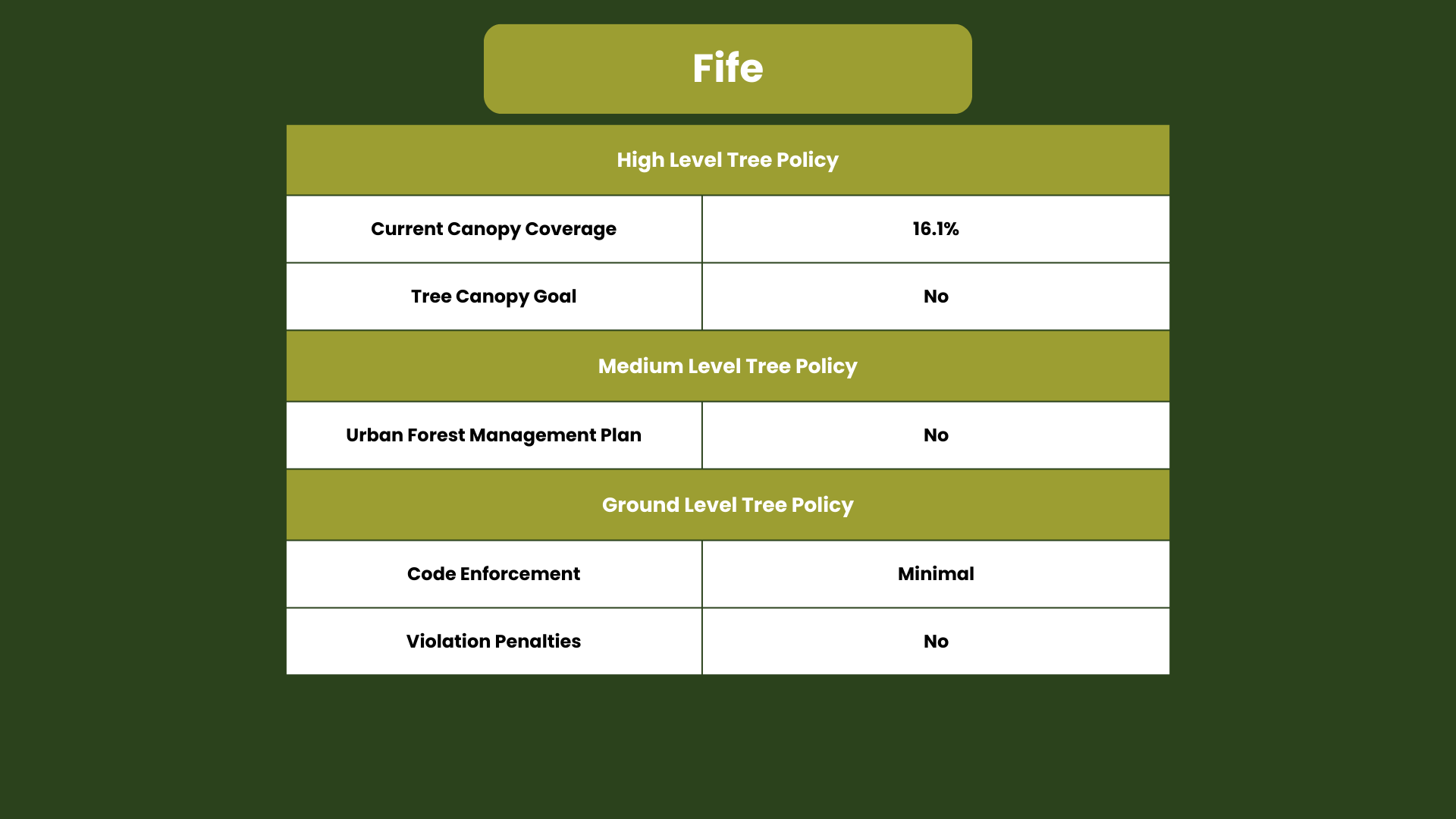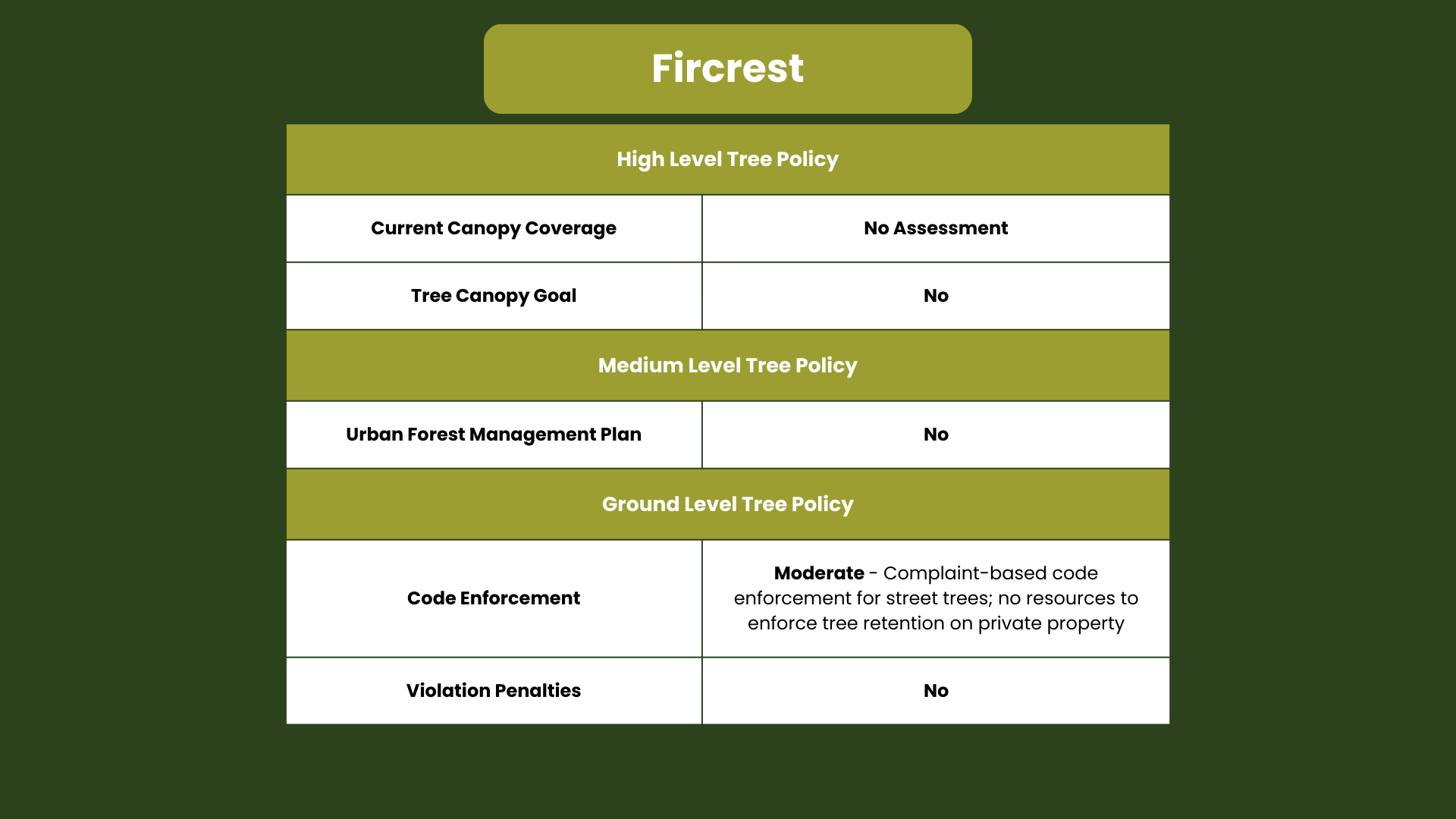
Advocacy
Why advocacy?
Advocacy is central to our vision of the future, where everyone in Greater Tacoma has access to the benefits of trees and shares the responsibility of our collective urban forest.
Our urban forest is cared for and managed by a web of agencies, organizations, and individuals. A large share of our existing canopy—not to mention available plantable space—is in parks, in open spaces, and on private property. Advocacy is an important tool we have to make sure these networks are aligned in this vision and making significant progress towards the shared goal of increasing stewardship and tree benefits.
We are facing multiple challenges in expanding the urban tree canopy across Tacoma. Financial and material barriers limit program funding. Staffing barriers limit capacity to actively plant and care for new and existing trees. Physical and built environment barriers limit our plantable space. Advocacy is how we are leveraging our skills, expertise, and passion for our urban forest to combat these barriers.
TTF’s primary role in the policy and advocacy space is to serve as a resource for community members, as well as for cities whose work in urban forestry is just getting started. Our expertise in policy is general and is primarily geared toward creating pathways for community members to advocate for increased tree benefits where they are.
This is the landing page for our Advocacy Program — stay tuned for additional resources and information.
Advocacy Agenda
The TTF Board of Directors play an active role in our advocacy approach. Members of the Board convene monthly as an Advocacy Committee to discuss established advocacy priorities and new policy developments across our web of partners. The expertise and diversity of experience held by our Board informs our advocacy efforts and engagement with partners. TTF updates our advocacy priorities yearly.

Tree Benefits
These types of benefits can support the argument of why we need trees in cities. Think about which benefits matter to you the most, and feel free to use these facts when you are advocating for trees!
-
Noise pollution can cause tension, anxiety, illness, and hearing loss but trees can be a tool for mitigating these effects. Trees and vegetated buffers absorb, deflect, or refract sound waves, reducing noise pollution and its negative effects in our neighborhoods. Vegetated buffers also serve as visual screens, enhancing privacy. (1)
Street trees calm traffic by modifying motorist behavior through “edge effect”, which cues drivers to slow speeds. Tree lined urban roads with landscape improvements experience decreased crash rates and are safer for pedestrians and cyclists. (1)
Trees have the power to bring together communities. Participating in a tree planting event or organizing with your neighbors to bring trees to your street are both strategies for increased community cohesion and connectedness. (1)
-
Carefully positioned trees can reduce a household’s overall energy consumption by 25%. Households may also see a 30% reduction in air-conditioning needs and 20–50% saving on heating costs, when trees are placed strategically around buildings. (2)
By providing shade, trees lower surface and air temperatures in the warmer months. In our cities, trees can lower temperatures up to 10°F, by providing shade and cooling through evapotranspiration. On a sunny day, the cooling effect of one tree through evapotranspiration is equivalent to at least 10 air conditioners. (2, 3)
-
Investments in trees bring noticeable returns: each dollar spent on tree planting and care can generate two to five times that investment. (2)
A study from Portland, Oregon, showed that on average, houses with more trees commanded higher rent prices. On average, a tree in a house’s yard increased monthly rent by $5.62, and a tree in the public right of way increased rent by $21.00 a month. (4)
Trees can provide economic benefits to their broader neighborhood. Research shows that a tree with about 300 square feet of canopy coverage can provide, on average, $9,200 to the value of neighboring houses. (4)
Research shows that transforming vacant or underutilized lots in cities into maintained green space can bring significant economic benefits to the community. Researchers in Philadelphia found that homes experienced approximate gains in value of 18% to 21% following the conversion of nearby vacant lots into maintained green space. This means that for every dollar spent to convert and maintain a vacant lot, there was an estimated $7.43 gain in additional property tax revenues. (5)
-
When rain water hits the ground, it collects pollutants, heavy metals, and oils found in our urban environments. This runoff is called stormwater. Trees help prevent stormwater runoff in our cities by intercepting rainfall, reabsorbing water through their root systems, and filtering collected water. This process cleans our water, protects marine wildlife and environments from pollutants, and reduces costs associated with filtering stormwater. (6)
-
Proximity to greenspace can be an important motivator for active lifestyles. One research study demonstrated that in areas with more greenspace, residents were more than three times as likely to be physically active. Research from the University of Washington further illustrates that green streets promote more active modes of transportation, including walking and biking. (5)
Street trees reduce nearby indoor air pollution by more than 50%. (2)
Trees and greenspace play a significant role in improving mental health. Results from a study in Philadelphia, Pennsylvania, show that converting vacant lots to maintained community greenspaces significantly improved feelings of depression and worthlessness among study participants. (7)
Even just looking at trees improves our health! Research shows that office workers with a view of trees report significantly less stress and greater job satisfaction. (2)
Fruit trees in parks and along urban streets provide healthy, accessible, and sustainable food resources to our communities. (1)
Maps Tell A Story
Maps hold power. They provide crucial context and data for understanding patterns in our communities. Maps as an advocacy tool illuminate the need for increased funding, programming, or focus in particular areas. Local data is highly impactful for illustrating the need for trees in your community.
Explore the maps below to learn more about the areas where you live, work, and play.
Tree Equity Score - American Forests
The Tree Equity Score tool is useful for gaining location specific information, including tree canopy data and neighborhood demographics. Put in your housing address to the search bar and TES will give you an individualized report based on the Census tract level. Highlighting the tree canopy % around your home or apartment may help you to explain the need for planting more trees in your neighborhood!
Washington Environmental Health Disparities Map
Did you know that different zip codes have different levels of exposure to environmental harm? This map shows where those areas are in Tacoma and around the state. Working toward tree equity helps improve the environmental conditions that healthy communities need.
City of Tacoma Community Forestry Map
This map tells the story of how trees intersect with equity and human health in the City of Tacoma. The tool combines data from Tacoma’s Equity Index, Urban Heat Island temperature distribution, existing tree canopy, and available planting space, to generate a planting prioritization score.
Resources for Renters
We often get the question: “I’m a renter, what can I do to bring trees to my place?”.
While renters often don’t have decision-making power about how their environment is managed, in some cases they are able to work with their landlords to bring positive changes to their homes.
Across Tacoma, up to 50% of households are renters. Rates of rentership are typically higher in lower income neighborhoods, which also have lower tree equity. Racial disparities persist among homeownership rates, household income, and housing cost burden, with non-White households having lower rates of homeownership and lower household income (One Tacoma). Trees can be a resource for increasing property values* and improving community health.
Most tree incentive programs allow renters to participate with signed permission from their landlord. Visit Trees for Greater Tacoma to find a program that is right for you and where you live, then encourage your landlord to sign up!
Talking with your neighbors can also strengthen your case. Collaborating on a letter or email to send to your landlord shows the collective action and interest from you and other tenants in improving the property and living experience. Offering to plant and care for the new trees can positively influence your landlord to agree to the property improvements.
Throughout this page are resources and data that can be used to craft a letter to your landlord in support of planting trees.
*Property values are often tied to gentrification. If done strategically, trees can also be a tool of empowerment that help communities resist the displacement caused by gentrification.
Tree Policies of Pierce County
Tree policies are diffuse and live in many different areas of the municipal code. The information compiled here is a snapshot in time at the beginning of 2024 and may be subject to new changes or revisions in city code. This project was made possible by funding from the Tacoma-Pierce County Health Department along with time and expertise from staff across the local jurisdictions.
Explore the infographics below to learn more about the tree policies in each city.
Click here to explore the full spreadsheet!
Project Background
Local tree policy is crucial to expanding and caring for our urban forest.
The TTF team conducted a review of tree policies across cities in Pierce County during 2023-2024. The goal of this project was to create a central information hub of local tree related policies across the county. The information compiled here can be a resource to compare and contrast policies across our county and explore the different types of tree policy.
This map shows tree equity scores across Pierce County, darker colors represent areas with the highest need for trees.
Introduction to Land Use — City Beautiful Basics
This video provides an introduction to zoning codes, comprehensive land use planning, and the importance of regional coordination.
Influencing Policy and Planning: A Civic Engagement Toolkit
This toolkit was created to help educate key stakeholders on how to effectively engage in advocacy discussions around land use planning and natural resource management decisions. Informed, organized, and prepared community members create meaningful impacts in the policy and planning processes that affect their neighborhoods. Explore this toolkit to learn more about the civic engagement process, the key players involved in environmental and land use decision making, and tools for effectively communicating your advocacy goals.
This toolkit was developed by Forterra for the Pierce County Conservation District, the Puyallup Watershed Initiative, and the Puyallup River Watershed Council.
Tree Equity Handbook
This handbook was created by American Forests and is an all-inclusive resource for building and supporting tree equity in your community. It offers in depth information, practical tips, and interactive resources to support you through every stage of your advocacy journey. Current sections of the handbook include: Collect Baseline Data, Build an Inclusive Coalition, Coalition Action Planning, and Create Plans and Policies, with more coming soon.
Click on the image below to explore the handbook!

















